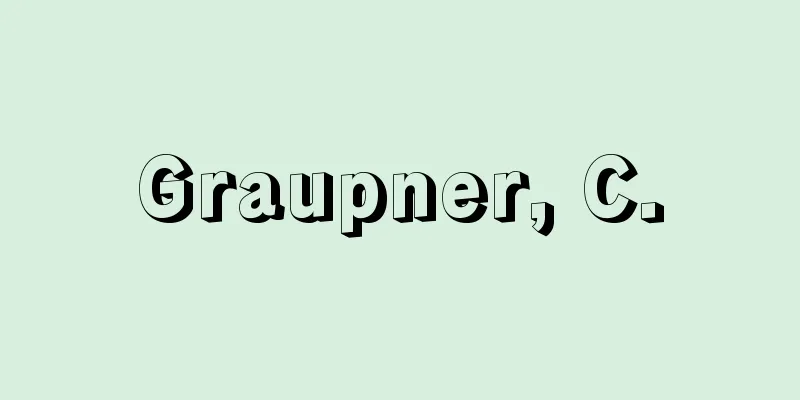Bearing - bearing

|
A mechanical part that supports a rotating shaft. Also called a bearing. It supports a rotating or oscillating shaft, receives the load applied to the shaft, and rotates or oscillates around the center of the shaft. Friction associated with the rotation of the shaft generates heat and wear, resulting in power loss. Materials and shapes are designed to reduce frictional resistance and wear, and various lubricants are used to ensure smooth rotation and oscillation. The part of the shaft that contacts the bearing is called the journal, and depending on the state of contact between the journal and the bearing, bearings can be broadly classified as sliding bearings (flat bearings) and rolling bearings. They can also be classified as radial bearings and thrust bearings depending on the direction of the load applied to the shaft. [Hidetaro Nakayama] Plain bearingsA bearing that supports the shaft while sliding on the contact surface of the shaft and bearing, using a lubricant, is also called a plain bearing. Because they are in contact with each other over a wide area, friction increases when the shaft rotates, which generates heat and causes the temperature of the shaft and bearing to rise. If they get too hot, they will burn out and become unable to rotate. To prevent this, a thin space is created between the shaft and the bearing, and lubricating oil is put into this space for operation. The lubricating oil enters the wedge-shaped gap and generates hydraulic pressure, and the shaft floats on the oil film, creating a fluid friction state, preventing heat generation while rotating. Because they are in contact with each other over a wide area, they can withstand large loads. The simplest type is a frame made of cast iron with a circular hole drilled in it. The part that comes into contact with the shaft does not wear much, and many bearings are equipped with bearing metal made of a material that fits well with the shaft. If the bearing metal wears out, it can be removed from the bearing body and easily replaced. Usually, they are made of white metal, kelmet, bronze, phosphorus bronze, etc. These bearings are not only one-piece, but also divided into two pieces. As described above, bearings in which a load is applied perpendicular to the shaft are called radial bearings, and those in which a load is applied in the axial direction are called thrust bearings. A thrust bearing is designed to support the tip of the shaft with its bottom surface. Since the area that receives the load is small, it generates heat and operates poorly when the shaft rotates at high speed or is subjected to a large load. Thrust bearings that have a small shaft diameter and are used with relatively small loads are called pivot bearings. Thrust bearings that support the gears of a clock have tapered tips to reduce friction. [Hidetaro Nakayama] Rolling bearingsA bearing with rolling elements such as balls or rollers between the inner and outer rings, it rotates more smoothly than a plain bearing. Bearings with balls are called ball bearings, and those with rollers are called roller bearings. The balls or rollers are held in place by a cage so that they do not come into contact with each other. The inner ring is fitted onto the rotating shaft, and the outer ring is fitted into the outer bearing hole. Bearings in which the load is applied perpendicular to the rotating shaft are called radial bearings, and those in which the load is applied in the axial direction are called thrust bearings. Roller bearings have a larger contact area than ball bearings, so they can withstand heavy loads. They are also suitable for situations where there is a large impact force. Bearings with one row of balls or rollers are called single-row bearings, and those with two rows are called double-row bearings. Ball bearings are highly accurate, and as mentioned above, have an extremely small contact area and low friction loss, so they are widely used and suitable for high accuracy and high speed rotation. Roller bearings are used where the load is relatively large, and when cylindrical rollers are used, they are called cylindrical roller bearings. When the roller diameter is relatively small and needle-shaped rollers that are long compared to the diameter are used, they are called needle roller bearings. These bearings have a small cross-sectional height and can support large loads in a small space compared to other bearings. Bearings with conical rollers are used for shafts that simultaneously bear loads perpendicular to the axis of rotation and loads in the direction of the axis of rotation. These are called tapered roller bearings. Self-aligning roller bearings, which use cylindrical rollers with a bulge in the middle, known as beer barrel shaped rollers, are also used. These are convenient because even if the shaft bends slightly during use or if there are minor assembly imperfections, the center of the bearing is automatically adjusted during rotation. The shapes of these rolling bearings are standardized internationally. There are also standards for their precision, with standards ranging from normal precision of class 0 to classes 6, 5, 4, and 2 in increasing precision. [Hidetaro Nakayama and Shinji Shimizu] [Reference items] | | |©Makoto Takahashi Plain bearings (thrust and radial bearings) ©Makoto Takahashi Main types of rolling bearings Source: Shogakukan Encyclopedia Nipponica About Encyclopedia Nipponica Information | Legend |
|
回転軸を支える機械部品。ベアリングbearingともいう。回転あるいは揺動する軸を支え、軸に加わる荷重を受け、軸心を中心に回転、揺動するようにしてある。軸の回転に伴う摩擦のために発熱、摩耗があり、動力損失が生ずる。摩擦抵抗と摩耗を減少するために材質や形状をくふうし、また円滑な回転、揺動するために各種の潤滑剤が使用される。軸受に接触している軸の部分をジャーナルjournalというが、ジャーナルと軸受との接触状態により、軸受をすべり軸受(平(ひら)軸受)と、ころがり軸受とに大別することができる。また軸に加わる荷重の方向によりラジアル軸受とスラスト軸受に分けることもできる。 [中山秀太郎] すべり軸受軸と軸受との接触面に潤滑剤を用いて滑り接触をしながら軸を支える軸受で、平軸受ともよばれる。互いに広い面で接触しているので軸が回転すると摩擦が多くなり、そのために発熱し、軸や軸受の温度が上昇する。あまり高温になると焼き付いて回転が不可能となる。これを防ぐために、軸と軸受との間に薄い空間をつくり、潤滑油をこの空間に入れて運転する。潤滑油は、くさび状のすきまに入り込み油圧を発生し、軸は油膜に浮かぶ流体摩擦状態となり、発熱を防止しながら回転する。互いに広い面で接触しているので大きな荷重にも耐えられる。もっとも簡単なものは、鋳物でつくったフレームに円形に穴をあけたものである。軸と接触する部分はあまり摩耗せず、そして軸になじみやすい材料でつくった軸受メタルを取り付けたものが多く使用されている。軸受メタルは摩耗すれば軸受本体から取り外し容易に交換できる。普通、ホワイトメタル、ケルメット、青銅、リン青銅などでつくられている。この軸受には、一体のものだけではなく、2個に分割されたものある。 以上のように、軸に対して荷重が直角方向に加わる軸受をラジアル軸受といい、軸方向に荷重の加わるものをスラスト軸受という。スラスト軸受は、軸の先端を軸受の底面で支える仕組みになっている。荷重を受ける面積が小さく軸が高速回転あるいは大荷重のときには発熱して、ぐあいが悪い。軸の径が小さく比較的小荷重のところに用いられるスラスト軸受を、ピボット軸受という。時計の歯車を支えるスラスト軸受は、摩擦を減らすために先端を細くしてある。 [中山秀太郎] ころがり軸受軸受の内輪と外輪の間に玉(ボール)やころといった転がり要素を入れたもので、すべり軸受より回転は軽快である。玉を入れたものを玉軸受(ボールベアリング)、ころを入れたものをころ軸受(ローラーベアリング)という。ボールやころは互いに接触しないように、保持器によって保持されている。内輪を回転する軸にはめ込み、外輪を外側の軸受用穴にはめ込むようになっている。荷重が回転軸に直角方向に加わるものをラジアル軸受といい、軸方向に加わるものをスラスト軸受という。ころ軸受は、玉軸受よりも接触面積が大きいので、大きい荷重に耐えることができる。また打撃力の大きい場合にも適している。玉やころが1列のものを単列形、2列のものを複列形という。 玉軸受は、高精度で、前述のように接触面積がきわめて小さく、摩擦損失が小さいので、広く用いられ、高精度・高速回転に適している。ころ軸受は、荷重がある程度大きいところに用いられ、円筒状のころが用いられている場合は、円筒ころ軸受とよぶ。また、ころの直径が比較的小さく、長さが直径に比べて長い針状のころが用いられている場合は、針状ころ軸受(ニードルベアリング)とよぶ。この軸受は、断面高さが小さく、他の軸受と比較して、小さなスペースで大きな荷重を支えることができる。 回転軸に垂直な荷重と回転軸方向の荷重とを同時に受ける軸には円錐(えんすい)形のころを使用した軸受が用いられる。これを円錐ころ軸受という。また円筒形の中央が膨らんだ、いわゆるビヤ樽(だる)形のころを使用した自動調心ころ軸受も使われている。これは使用中に多少軸がたわんでも、組立てが少々不備でも、回転中に軸受の中心が自動的に調節されるので便利である。 これらのころがり軸受の形状は国際的に統一されている。また精度についても規格があり、普通精度の0級から精度が高くなるにしたがい、6、5、4、2級が規定されている。 [中山秀太郎・清水伸二] [参照項目] | | |©高橋 真"> 平軸受(スラスト軸受とラジアル軸受) ©高橋 真"> ころがり軸受のおもな種類 出典 小学館 日本大百科全書(ニッポニカ)日本大百科全書(ニッポニカ)について 情報 | 凡例 |
<<: Bearing steel - Jikuukekou (English spelling) Bearing steel
Recommend
Lacrimal gland
…The organ involved in the secretion and discharg...
Satsumaage - Fish cakes
This is fried kamaboko made by deep-frying paste ...
Danso Kiyota
1719-1785 A Confucian scholar in the mid-Edo peri...
Akeno [town] - Akeno
A former town in Makabe district, western Ibaraki ...
Blueprint - Aojashin
A type of copying method that uses chemically sen...
Inugami Mochi - Inugami Mochi
...A type of tsukumono found mainly in Shikoku, e...
Jin Ming Dynasty
1600-? A painter of the Joseon Dynasty. Born in t...
rapid transit
...Train buses have the characteristics of guidew...
Black dot ringworm
...Moisture and redness are relatively rare, and ...
S twist - S twist
…Filament yarns can have no twist at all, or they...
Osiris
…His aim was to study the history of science from...
Cerambycidae
…General term for insects belonging to the family...
Intoxicology
… On the other hand, the following are interdisci...
Northern Rhodesia
…Official name: Republic of ZambiaArea: 752,614 k...
Stubborn itching -
A skin disease caused by infection with various ty...









